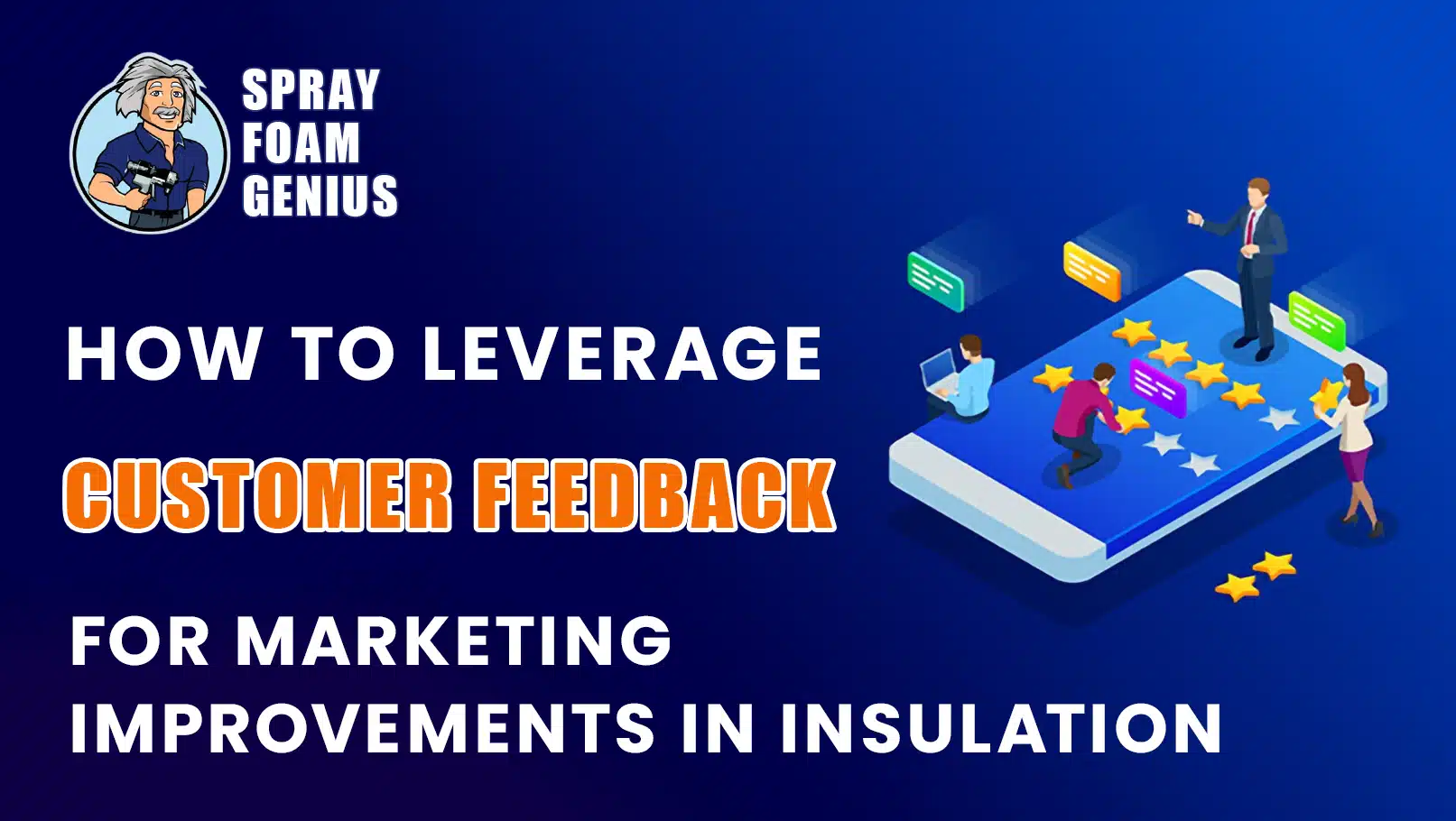
In the competitive landscape of the insulation industry, customer feedback is a powerful tool that can significantly enhance our marketing strategies. At Spray Foam Genius Marketing, we understand the importance of harnessing this feedback to drive improvements and foster growth. By prioritizing customer insights, insulation contractors in the USA and Canada can enhance their services, boost customer satisfaction, and ultimately increase sales. In this comprehensive guide, we’ll explore how to effectively leverage customer feedback for marketing improvements while adhering to the latest Google updates and best practices in CRM and customer management.
Understanding the Importance of Customer Feedback
Customer feedback is invaluable for insulation contractors, offering insights into client satisfaction, areas for improvement, and emerging market trends. By actively soliciting and analyzing feedback, contractors can identify what resonates with customers and what does not. This data-driven approach not only helps in refining marketing strategies but also strengthens the relationship between contractors and their clients.
Benefits of Leveraging Customer Feedback
- Enhances Customer Experience: Understanding customer preferences allows contractors to tailor their services, creating a more personalized experience.
- Informs Product Development: Insights from customers can guide the development of new insulation products or services that meet market demands.
- Boosts Reputation: By responding to feedback and making necessary adjustments, contractors can enhance their reputation as responsive and customer-focused businesses.
- Drives Marketing Strategies: Feedback can inform targeted marketing campaigns that speak directly to customer needs and preferences.
Collecting Customer Feedback Effectively
To leverage customer feedback effectively, insulation contractors must establish a systematic approach to collecting and analyzing insights. Here are several strategies we recommend:
1. Surveys and Questionnaires
Conducting surveys is one of the most effective ways to gather customer feedback. Here’s how to do it effectively:
- Keep It Short: Limit surveys to 5-10 questions to encourage completion.
- Use Open-Ended Questions: This allows customers to express their thoughts freely, providing richer insights.
- Incentivize Participation: Consider offering discounts or freebies to encourage more responses.
2. Customer Interviews
One-on-one interviews provide an opportunity for deeper insights. During these sessions:
- Ask Probing Questions: Explore specific experiences and feelings about your services.
- Listen Actively: Show genuine interest in what the customer has to say, which builds trust and rapport.
3. Online Reviews and Ratings
Encouraging customers to leave reviews on platforms like Google My Business is essential. Here’s how to manage this:
- Prompt for Feedback: After service completion, follow up with an email or message requesting a review.
- Monitor Reviews: Regularly check your online ratings and respond to both positive and negative reviews to show you value customer opinions.
4. Social Media Engagement
Social media platforms provide an excellent venue for gathering feedback. Utilize these strategies:
- Create Polls and Questions: Use features like polls on Instagram or Facebook to solicit quick feedback.
- Encourage Conversations: Engage with customers through comments and direct messages to gather informal insights.
Analyzing Customer Feedback

Once feedback is collected, the next step is to analyze it effectively. This process involves identifying patterns, common themes, and actionable insights. Here’s how we can approach this:
1. Categorize Feedback
Organize feedback into categories such as service quality, pricing, customer support, and product effectiveness. This will help identify specific areas for improvement.
2. Use Analytical Tools
Consider employing customer relationship management (CRM) software that includes feedback analysis tools. These can help automate the process of sorting and interpreting feedback.
3. Benchmark Against Competitors
Comparing feedback trends with competitors can provide valuable insights into market positioning. Identify what customers appreciate about your competitors and how you can differentiate your services.
4. Regularly Review Feedback
Establish a routine to review customer feedback. Monthly or quarterly reviews can help track improvements over time and keep the focus on areas needing attention.
Implementing Changes Based on Feedback
Acting on customer feedback is crucial for demonstrating that you value their opinions. Here’s how to implement changes effectively:
1. Prioritize Changes
Not all feedback will require immediate action. Prioritize changes based on the frequency and impact of the feedback. Focus on changes that can significantly enhance customer satisfaction and business performance.
2. Communicate Changes
Once improvements are made, communicate these changes to your customers. This could be done through newsletters, social media updates, or direct emails. Transparency fosters trust and shows customers that their feedback is taken seriously.
3. Monitor Results
After implementing changes, continue to monitor customer feedback to assess the effectiveness of the modifications. This ongoing process ensures that improvements meet customer expectations.
4. Solicit Follow-Up Feedback
After changes are made, reach out to customers to ask for their thoughts on the improvements. This shows customers that their opinions matter and provides additional data on whether the changes were successful.
Incorporating Feedback into Marketing Strategies
Customer feedback can significantly enhance your marketing strategies. Here are some ways to do this effectively:
1. Tailor Marketing Messages
Utilize insights from customer feedback to tailor your marketing messages. For example, if customers frequently mention the importance of energy efficiency, emphasize this feature in your advertising campaigns. This specificity makes your messaging more relevant and impactful.
2. Create Customer-Centric Content
Develop content that addresses common customer questions and concerns. Blog posts, FAQs, and video tutorials can be great ways to share valuable information while showcasing your expertise in insulation solutions.
- Educational Content: Use feedback to identify knowledge gaps and create informative content that addresses these areas.
- Visuals and Infographics: Visual content can help communicate complex information effectively and engage customers more than text alone.
3. Utilize Testimonials and Case Studies
Highlight positive feedback in your marketing materials. Customer testimonials and case studies can be powerful tools to build trust and credibility. Use these in social media campaigns, on your website, and in email marketing.
- Feature Stories: Share success stories that showcase how your services solved a customer’s problem. This not only promotes your business but also helps potential customers relate to your current clients.
- Video Testimonials: Consider creating video testimonials that add a personal touch and authenticity to the stories.
4. Leverage User-Generated Content
Encourage satisfied customers to share their experiences on social media. User-generated content not only serves as authentic endorsements but also increases your brand’s visibility.
- Hashtag Campaigns: Create a unique hashtag for customers to use when sharing their experiences with your services. This encourages community and promotes your brand organically.
- Contests and Giveaways: Consider running contests that reward customers for sharing their experiences or photos of your work, further incentivizing user-generated content.
Maintaining a Feedback Loop
Creating a culture of continuous feedback is essential for long-term success. Here’s how to maintain this loop:
1. Regular Check-Ins
Schedule regular check-ins with customers to solicit feedback on their ongoing experiences. This can be done through periodic surveys or personal outreach.
2. Stay Engaged
Engage with customers consistently through newsletters, social media updates, and informative content. Keeping the lines of communication open encourages ongoing feedback.
- Informative Updates: Regularly share industry insights, new services, or tips related to insulation, which keeps your brand top-of-mind for customers.
- Email Newsletters: Use newsletters to keep customers informed about your services and encourage them to provide feedback.
3. Be Responsive
Make it a priority to respond to customer feedback promptly. Whether positive or negative, timely responses show that you care about customer opinions and are committed to improving.
- Thank Customers: Acknowledge positive feedback with a simple thank you, and address any negative feedback with a plan for resolution. This shows you’re listening and taking action.
- Engage in Conversations: Take the time to respond thoughtfully to feedback, especially on public platforms. This demonstrates your commitment to customer service.
Building Trust through Feedback
Trust is paramount in the insulation industry. Here’s how leveraging feedback can help build trust with your customers:
1. Transparency
Be open about how you use customer feedback to enhance your services. This transparency can increase customer confidence in your brand.
- Share Improvement Stories: Regularly share updates on how feedback has led to specific improvements, reinforcing the message that you value customer input.
- Feedback Process: Explain how feedback is collected and utilized, which can demystify the process for customers and enhance their sense of involvement.
2. Acknowledge Mistakes
If feedback indicates areas where you’ve fallen short, acknowledge these shortcomings and communicate your plans for improvement. Customers appreciate honesty and are more likely to remain loyal when they see you taking responsibility.
- Own Up to Mistakes: When issues arise, address them directly and communicate your strategies for resolution, turning potential negative experiences into opportunities for improvement.
- Learn and Adapt: Show customers that you’re learning from their feedback and evolving as a business. This not only builds trust but also positions your brand as adaptable and customer-focused.
Take Action Now!
As insulation contractors, leveraging customer feedback is not just about collecting insights; it’s about creating a responsive and customer-centric business model that drives success. By systematically gathering, analyzing, and implementing changes based on feedback, we can significantly improve our marketing strategies and customer satisfaction.
If you’re ready to enhance your marketing efforts and leverage customer feedback for success, we’re here to help! Contact Spray Foam Genius Marketing today at 877-840-FOAM for the USA or 844-741-FOAM for Canada. You can also visit our website at sprayfoamgeniusmarketing.com or email us at [email protected].
Let’s work together to take your insulation business to the next level!
- 5 Google My Business Hacks to Double Your Leads for Spray Foam Insulation Contractors - January 14, 2025
- Why Spray Foam Contractors Cannot Ignore Reputation Management in 2025 - January 13, 2025
- Local SEO Secrets Every Spray Foam Contractor Must Know to Win in 2025 - January 13, 2025

